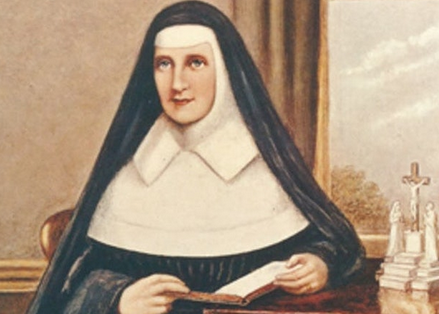John Murray continues his series on women of faith with an article on Catherine McAuley, Foundress of the Sisters of Mercy and formerly honoured on the Irish five pound note.
‘It was an honour but it really should have been the twenty pound note!’ ‘Do you not think that Catherine would have been happy with her face on the smaller note – sure, the fiver reached more poor people’s pockets than the larger one’. So the conversation went.
Who was this woman, whom Pope John Paul declared Venerable in 1990, whom the state depicted on its currency, who was also a contemporary of Dickens and the Brontes, and a Founder of a religious congregation still thriving today?

Catherine McAuley was born in 1778 into a wealthy Catholic family in Dublin, Ireland. Her father, a kind and devoted man, cared deeply for his family and also loved his faith. One of Catherine’s memories would be the Sundays when James would welcome many of the local poor to receive food parcels and then tell the children stories including many from the Bible. Sadly he passed away when Catherine was only five but his example influenced her throughout her life.
However something else strongly touched Catherine’s young life – the world of dances and parties which were part of the ‘in’ set. Catherine was a gifted dancer and popular on the scene. Her sister and brother had both married well but had stopped practising their faith – they wanted her to take her place in society and perhaps like them find a spouse.
Circumstances took a different direction. When Elinor, her mother died some years later, Catherine who was only twenty at the time, went to live with William and Catherine Callaghan, who were an elderly Protestant couple. She continued to look after them right up to their deaths. Inspired by her example, both of them became Catholic just before their deaths.
It was during this period that a vocation grew within her young heart. Even while she was caring for the Callaghan’s, Catherine also found time to reach out to the many poor of the Coolock area where she lived and beyond in the city of Dublin. It broke Catherine’s heart to witness the poverty which was so prevalent then. Often – with Fr. Nugent, the local priest, and a friend – she ventured out to distribute food and clothes to the children of the streets. On one such visit she met Mrs Harper who lived in terrible conditions and had not seen soap or water in fifty years! Catherine took her home and despite her lack of gratitude treated her like a queen.
Not everyone appreciated Catherine’s concern.

When the Callaghan’s passed away, the estate they owned passed to her and she was able to use the money from the sale to build a fine house in Baggot Street in the centre of the city. This became a home for young women and orphans as well as the beginning of a school for poor children. Catherine also attended the sick by visiting their own homes and often walked the streets to help those who were in need.
It would be fair to say that Catherine never intended to found a religious congregation. Indeed the clergy and often the laity of the time were not supportive of groups of lay women working independently of Church structures. But Catherine’s concern was for the stability and continuity of the works of mercy which the women had begun to take on. Should someone leave for marriage or even lose interest she knew the poor would suffer.
The Archbishop of Dublin, Dr. Murray had given permission to the staff of the original institute to wear a distinctive dress and to publicly visit the sick. With his encouragement – in 1831 – Catherine came up with the idea of the ‘Sisters of Mercy’ because she wanted so much to make the works of mercy the distinctive feature of the new order. Soon Catherine and two friends entered the formation programme of the Presentation Sisters to formally prepare for life as women religious. They realised that the young order’s enthusiasm and early shoots needed the structure of a rule and a proper governance.
The early rigours took their toll – establishing the order, her thousands of letters, the practical daily care for the poor, the exertions of dealing with the cholera epidemic in Dublin in 1832 – Catherine only lived ten more years as a Sister. She died of tuberculosis – a scourge of Ireland in the nineteenth century – on 11th November 1841 at the original house in Baggot Street. ‘I am not afraid’ she told those gathered round her bed and famously reminded Sr. Teresa to make sure everyone got a good cup of tea before they left.
At the time of her death there were already 100 Sisters working in ten different foundations throughout the country. Within a short time small groups of Sisters left Ireland to establish houses in the United States as well as Australia, New Zealand and Argentina. At the height of the order’s work there were almost 10,000 Sisters throughout the world with the Mercy International Centre in Dublin being the Mother House of the order. In 1978 Pope Paul VI opened the cause for beatification for Catherine – the woman who had graced the fiver.
This article was first published in the Sacred Heart Messenger


